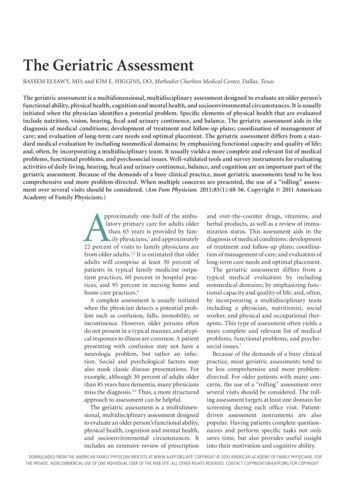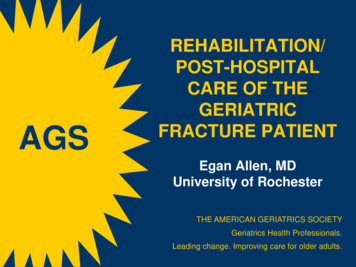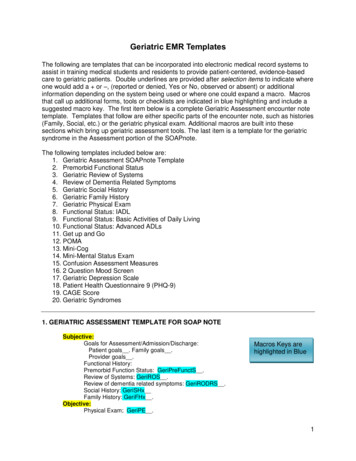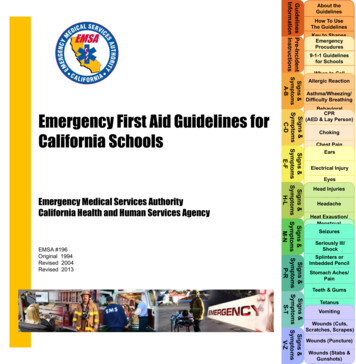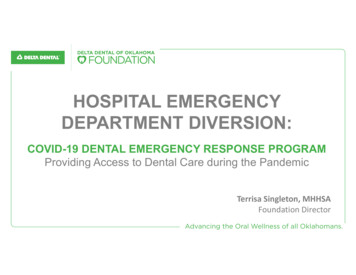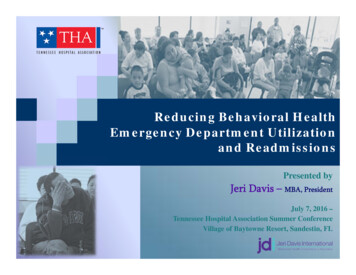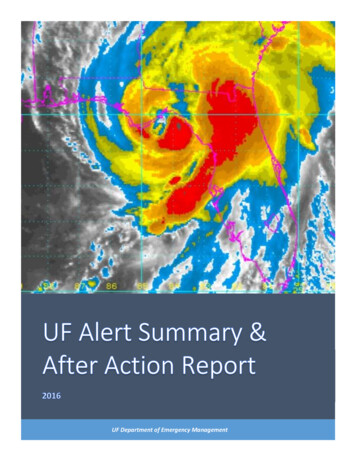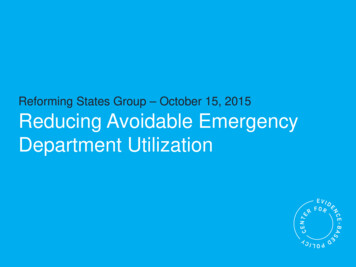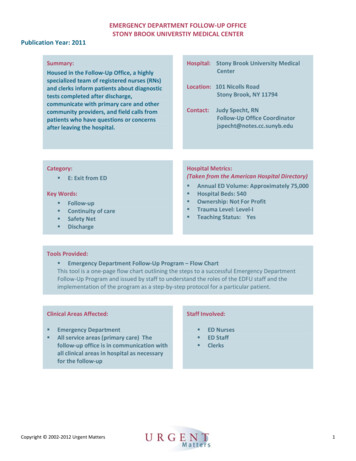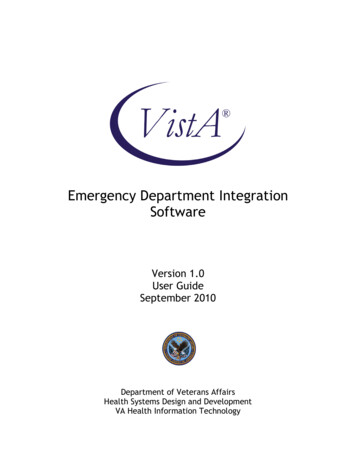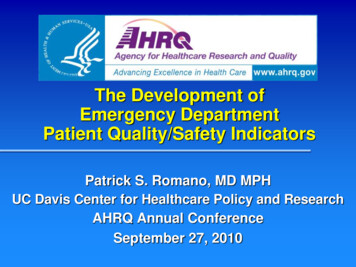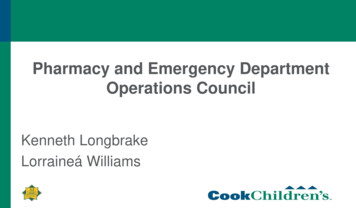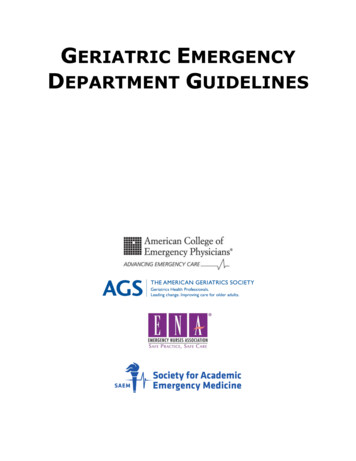
Transcription
GERIATRIC EMERGENCYDEPARTMENT GUIDELINES
APPROVED BY THE ACEP BOARD OF DIRECTORS, OCTOBER 2013APPROVED BY THE SAEM BOARD OF DIRECTORS, OCTOBER 2013APPROVED BY THE AGS BOARD OF DIRECTORS, DECEMBER 2013APPROVED BY THE ENA BOARD OF DIRECTORS, JANUARY 2014Copyright 2013. American College of Emergency Physicians, The AmericanGeriatrics Society, Emergency Nurses Association, and the Society for AcademicEmergency Medicine.
1THE GERIATRIC EMERGENCY DEPARTMENT GUIDELINESTable of ContentsIntroduction . 2Purpose . 3GoalsBenefitsStaffing and Administration . 4BackgroundRecommendationsGeriatric Emergency Department Medical DirectorGeriatric Emergency Department Nurse ManagerStaff PhysiciansStaff NursesMedical Staff SpecialistsAncillary ServicesFollow up and Transition of Care . 6BackgroundRecommendationsEducation . 8Quality Improvement . 9Geriatric Program Quality Improvement Plan . 9Sample Geriatric ED Quality Assessment Instrument (Dashboard) . 11Equipment and Supplies . 12Policies, Procedures, and Protocols . 14Sample Policies & ProceduresThe Screening of Geriatric Patients . 14Guidelines for the Use of Urinary Catheters . 16Geriatric Medication Management . 18Geriatric Fall Assessment . 24Delirium and Dementia . 26Palliative Care . 31References . 32Task Force Members . 40
2Geriatric Emergency Department GuidelinesThis document is the product of two years of consensus-based work that included representativesfrom the American College of Emergency Physicians, The American Geriatrics Society, EmergencyNurses Association, and the Society for Academic Emergency Medicine.INTRODUCTIONAccording to the 2010 Census, more than 40 million Americans were over the age of 65, whichwas “more people than in any previous census.” In addition, “between 2000 and 2010, the population65 years and over increased at a faster rate than the total U.S. population.” The census data alsodemonstrated that the population 85 and older is growing at a rate almost three times the generalpopulation. The subsequent increased need for health care for this burgeoning geriatric populationrepresents an unprecedented and overwhelming challenge to the American health care system as awhole and to emergency departments (EDs) specifically.1-4 Geriatric EDs began appearing in the UnitedStates in 2008 and have become increasingly common.5The ED is uniquely positioned to play a role in improving care to the geriatric population.6 As anever-increasing access point for medical care, the ED sits at a crossroads between inpatient andoutpatient care (Figure 1).7,8 Specifically, the ED represents 57% of hospital admissions in the UnitedStates, of which almost 70% receive a non-surgical diagnosis.9 The expertise which an ED staff can bringto an encounter with a geriatric patient can meaningfully impact not only a patient’s condition, but canalso impact the decision to utilize relatively expensive inpatient modalities, or less expensive outpatienttreatments.10, 11 Emergency medicine experts recognize similar challenges around the world.12 GeriatricED core principles have been described in the United Kingdom.13Figure 1. The central role of the ED in geriatric health care in contemporary medicine (reproduced with permission fromTeamHealth's Patient Care Continuum Model.)
3Furthermore, as the initial site of care for both inpatient and outpatient events, the careprovided in the ED has the opportunity to “set the stage” for subsequent care provided. More accuratediagnoses and improved therapeutic measures can not only expedite and improve inpatient care andoutcomes, but can effectively guide the allocation of resources towards a patient population that, ingeneral, utilizes significantly more resources per event than younger populations.9,14 Geriatric EDpatients represent 43% of admissions, including 48% admitted to the intensive care unit (ICU).15, 16 Onaverage, the geriatric patient has an ED length of stay that is 20% longer and they use 50% morelab/imaging services than younger populations.17, 18 In addition, Geriatric ED patients are 400% morelikely to require social services. Despite the focus on geriatric acute care in the ED manifest bydisproportionate use of resources, these patients frequently leave the ED dissatisfied and optimaloutcomes are not consistently attained.19-21Despite the fact that the geriatric patient population accounts for a large, and ever increasing,proportion of ED visits, the contemporary emergency medicine management model may not beadequate for geriatric adults.7,8 A number of challenges face emergency medicine to effectively andreliably improve post-ED geriatric adult outcomes.22 Multiple studies demonstrate ED physicians’perceptions about inadequate geriatric emergency care model training.14, 23 Many common geriatric EDproblems remain under-researched leaving uncertainty in optimal management strategies.24-26 Inaddition, quality indicators for minimal standard geriatric ED care continue to evolve.27 Older adults withmultiple medical co-morbidities, often multiple medications, and complex physiologic changes presenteven greater challenges.28,29 Programs specifically designed to address these concerns are a realisticopportunity to improve care.7,8Similar programs designed for other age groups (pediatrics) or directed towards specificdiseases (STEMI, stroke, and trauma) have improved care both in individual EDs and system-wide,resulting in better, more cost effective care and ultimately better patient outcomes.30-32GERIATRIC ED- PURPOSEPurposeThe purpose of these Geriatric Emergency Department Guidelines is to provide a standardizedset of guidelines that can effectively improve the care of the geriatric population and which is feasible toimplement in the ED. These guidelines create a template for staffing, equipment, education, policies andprocedures, follow-up care, and performance improvement measures. When implemented collectively,a geriatric ED can expect to see improvements in patient care, customer service, and staff satisfaction.7,11Improved attention to the needs of this challenging population has the opportunity to moreeffectively allocate health care resources, optimize admission and readmission rates, whilesimultaneously decreasing iatrogenic complications and the resultant increased length-of-stay anddecreased reimbursement.A goal of the geriatric ED is to recognize those patients who will benefit from inpatient care, andto effectively implement outpatient care to those who do not require inpatient resources. To implementmost effectively, the geriatric ED will utilize the resources of the hospital, ED and inpatient, as well asoutpatient resources. Making effective and expedient outpatient arrangements available to the geriatricpopulation is of critical importance to the care of this population, recognizing that acute inpatientevents are often accompanied by functional decline, increased dependency and increased morbidity.33,34By using providers, including nurse practitioners, nurses, social workers, physician assistants, andphysicians to coordinate care in the ED, the inpatient units, and during the immediate post-ED dischargeperiod, the geriatric ED creates the opportunity to care for geriatric patients in the environment mostconducive to a positive outcome.
4The benefits of the Geriatric ED to the geriatric patient population are multiple and clear. Byfocusing attention and resources on the most common needs of the geriatric ED patient, care can beoptimized. The benefit of a Geriatric ED to a hosting hospital can be multiple as well. These improvedpatient care standards can become a significant marketing tool for hospitals looking to reach out to theMedicare population and partner with extended care facilities. A Geriatric ED can market the ED toattract a patient population that may also utilize higher reimbursing hospital-based programs, includingcardiac, orthopedic, and neurologic care. Further, with Medicare reimbursements decreasing andpayment for iatrogenic complications such as wounds, catheter associated infections, etc. impactinghospital reimbursement; the need for special attention to geriatric needs has become even morepressing.The term “geriatric” has had different definitions over the past decades. In 1985, the term"oldest old" was coined to identify those 85 years of age and older. Later Fries, et al defined threegroups by dividing the older adult population into the young old (often 65-74), the middle old (75-85)and the oldest old ( 85).35, 36 The World Health Organization defined the older population starting at age60.37 Our guidelines used the construct that age 65 and older would be the geriatric population servedby the Geriatric ED. Many hospitals may find that using the age 65 and older does not match the needsof their population and available resources. It may be most appropriate that each hospital identify theage for patients to be seen in their Geriatric ED. Through the continuum of physiologic aging complexityof health care issues increase and as such, the benefits of a Geriatric ED increase concurrently. The agerange to be a patient in the Geriatric ED can be based on the literature, meaning age 60 or 65, or can bedefined by the specific hospital community. One hospital uses age 55 based on when resources areavailable; another uses 65 years of age and another uses 75 years of age as the beginning age range fortheir Geriatric ED.The recommendations found in this packet represent research and consensus-based bestpractices from the perspectives of the American College of Emergency Physicians, Society for AcademicEmergency Medicine, American Geriatrics Society, and Emergency Nurses Association. Withimplementation of the following recommendations, hospitals, regardless of size, will positively impactthe care of the geriatric emergency patients.STAFFING/ADMINISTRATIONThe Geriatric ED staff and administration provides a multi-disciplinary team of care providersfocused on the varying needs of the geriatric population. By providing trained staff in the ED, as well asreadily available staff for inpatient care and outpatient follow up, the Geriatric ED can optimize ED visits,effectively deliver and/or coordinate care in a less costly and more comfortable outpatient setting whenappropriate, and coordinate inpatient resources for high-risk patients. An effective program will involvehospital site-specific staff as well as overall local coordination resources.Background:Although published studies have not been clear on outcomes resulting from staffingmodifications for the care of geriatric patients, they have demonstrated high levels of endorsement forED staffing enhancements in general (94%), for the availability of specialized nurses (85%), pharmacists(74%), social workers (88%), geriatric consults (79%) and a designated professional to coordinategeriatric services (91%). There were moderate levels of endorsement for the availability of physicaltherapy (59%) and occupational therapy (53%).38One common approach to enhanced older adult ED staffing in the literature is the use ofgeriatric consultation services in the ED.39-42 Yuen, et al. found that over 26 months, there were 2202geriatric consultations (85 per month), with admission avoided in 85% (47% discharged home, 38%
5admitted to a “convalescent hospital”).42 Foo and colleagues evaluated geriatric assessment andintervention prior to discharge of geriatric patients from an ED observation unit. In the interventiongroup, 72% of patients had unrecognized needs requiring intervention. This group had fewer ED revisits(IRR 0.59) and hospital admissions (IRR 0.64) at 12 months.41 However, results are not consistent acrossstudies. Sinoff et al also evaluated an ED geriatric consult service and found a significantly higheradmission rate (64%), with a 2-year mortality of 34% and institutionalization rate of 52%.40 Socialworkers and case managers are essential to efficient geriatric ED management. Effective geriatric casemanagement strategies continue to evolve.43 Innovative models using volunteers to assess geriatric EDpatients have also been evaluated and are acceptable to ED nurses and physicians.29Recommendations:The Geriatric ED will have staffing protocols in place to provide for geriatric-trained providers,including physician and nurse leadership and ancillary services. These protocols should include plansfor times when such services may not be available.Staff members of the Geriatric ED will participate in educational/training to ensure high-qualitygeriatric care.Although departments may differ in the availability of staffing resources, departments should haveavailable the following positions either as part of a hospital-based Acute Care of Elders (ACE) teamor specific for the ED:Geriatric Emergency Department Medical DirectorQualifications:o Best practiced by a board-certified emergency physician with training ingeriatricso Completion of eight hours of geriatric appropriate CME every two yearsResponsibilities:o Member of hospital ED and Medicine committeeo Oversight of geriatric performance improvement programo Liaison with Medical Staff for geriatric care concernso Liaison with outpatient care partners including Skilled Nursing Facilities (SNFs),Board and Care facilities, home health providers, etc.o Identify needs for staff education and implement educational programs whenappropriate.o Review, approve, and assist in the development of all hospital geriatric policiesand proceduresGeriatric Emergency Department Nurse ManagerQualifications:o At least two years of experience in geriatrics (or in an ED that sees geriatricpatients) within the previous five yearso Experience with QI programs is recommendedo Completion of eight hours of Board of Registered Nursing (BRN) approvedcontinuing education units (CEU) in geriatric topics every two years.Responsibilities:o Participate in the development and maintenance of a geriatric performanceimprovement program
6oooLiaison with outpatient care partners including, but not limited to SNFs, Boardand Care facilities, home health providers, etc.Member of selected hospital-based ED and/or medicine committeesIdentify needs for staff education and implement educational programs whenappropriate.Staff PhysiciansProvide twenty-four hour ED coverage or directly supervised by physicians functioningas emergency physicians. This includes senior residents practicing at their respectivehospitals only.Staff physicians are encouraged to participate in geriatric specific education with a goalof 4 hours of CME annually specifically focused on the care of geriatric patients.Staff NursesNursing staff is encouraged to participate in geriatric specific education.Medical Staff SpecialistsSpecialists will be available for consultation either by established medical staff policiesor by pre-arranged transfer arrangements. Although each hospital’s medical staff willsupport different specialist services, it is recommended that the Geriatric ED haveaccess to:o Geriatricso Cardiologyo General Surgeryo GIo Neurologyo Orthopedistso Psychiatry, preferably with a geriatric specialtyo RadiologyAncillary ServicesCase management and social servicesMid-level provider/physician extenders (optional, but recommended)Occupational/Physical therapistsPharmacistsFOLLOW UP AND TRANSITION OF CAREAcute hospitalization is associated with increased rates of acute delirium, nosocomial infections,iatrogenic complications, and functional declines in the geriatric adult.44 Thus, one of the main goals ofthe Geriatric ED is to decrease hospital admissions. Making effective and expedient outpatientarrangements available to the geriatric population is of critical importance to the care of this population.However, discharge from the ED to the community presents significant challenges to the geriatricpopulation.
7Background:Published studies on ED-based interventions with improved access to community resourceshave had mixed results. Most demonstrate little effect of these interventions on either ED utilization orprevention of complications.45-48 However, effective transition of care is clearly required to facilitateoutpatient care after an ED evaluation. This transition process presents many challenges. In an era ofdaily ED crowding, effective, reliable discharge instructions are a challenge to all populations,particularly for the geriatric population.49 Older ED patients identify misinformation as a primary courseof dissatisfaction with their emergency care, a problem confounded and magnified by ongoing underrecognition of cognitive dysfunction, lower health literacy, and financial impediments for prescriptionsand recommended outpatient follow-up.50-52Recommendations:The Geriatric ED will have discharge protocols in place that facilitate the communication of clinicallyrelevant information to the patient/family and outpatient care providers, including nursing homes.Essential information to optimize continuity of care at the time of discharge should include thefollowing data elements:Presenting complaintsTest results and interpretationED therapy and clinical responseConsultation Notes (in person or via telephone) in EDWorking discharge diagnosisED physician note, or copy of dictationNew prescriptions and alterations with long-term medicationsFollow-up planClinical information will be presented in a format in a way best suited for elder adults:Large font discharge instructionsHealth Insurance Portability and Accountability Act (HIPAA) compliant copied dischargeinstructions should be provided to family and care providers.The Geriatric ED will have a process in place that effectively provides appropriate outpatient follow upeither via provider-to-patient communication or the provision of direct follow up clinical evaluation.Although telephone follow up is the most commonly used, the use of newer technology,including telemedicine alternatives is recommended.The Geriatric ED will maintain relationships
Geriatric Emergency Department Guidelines This document is the product of two years of consensus-based work that included representatives from the American College of Emergency Physicians, The American Geriatrics Society, Emergency Nurses Association, and the Society for A
